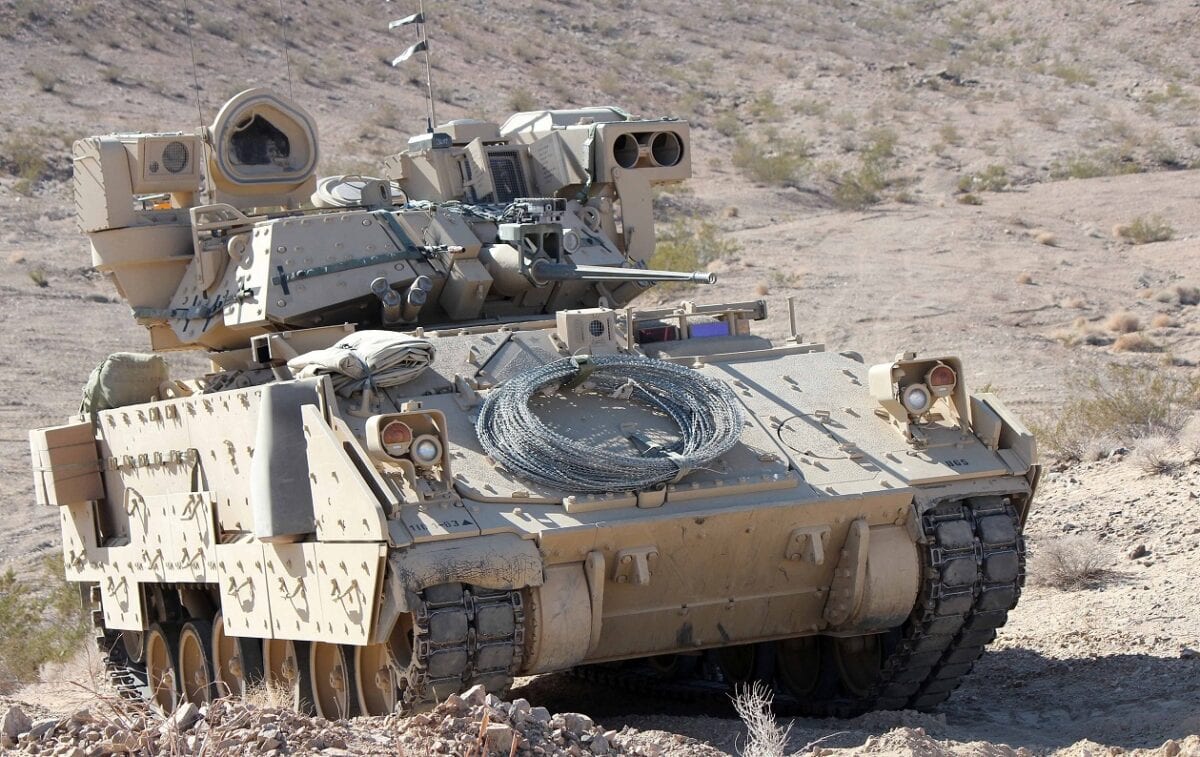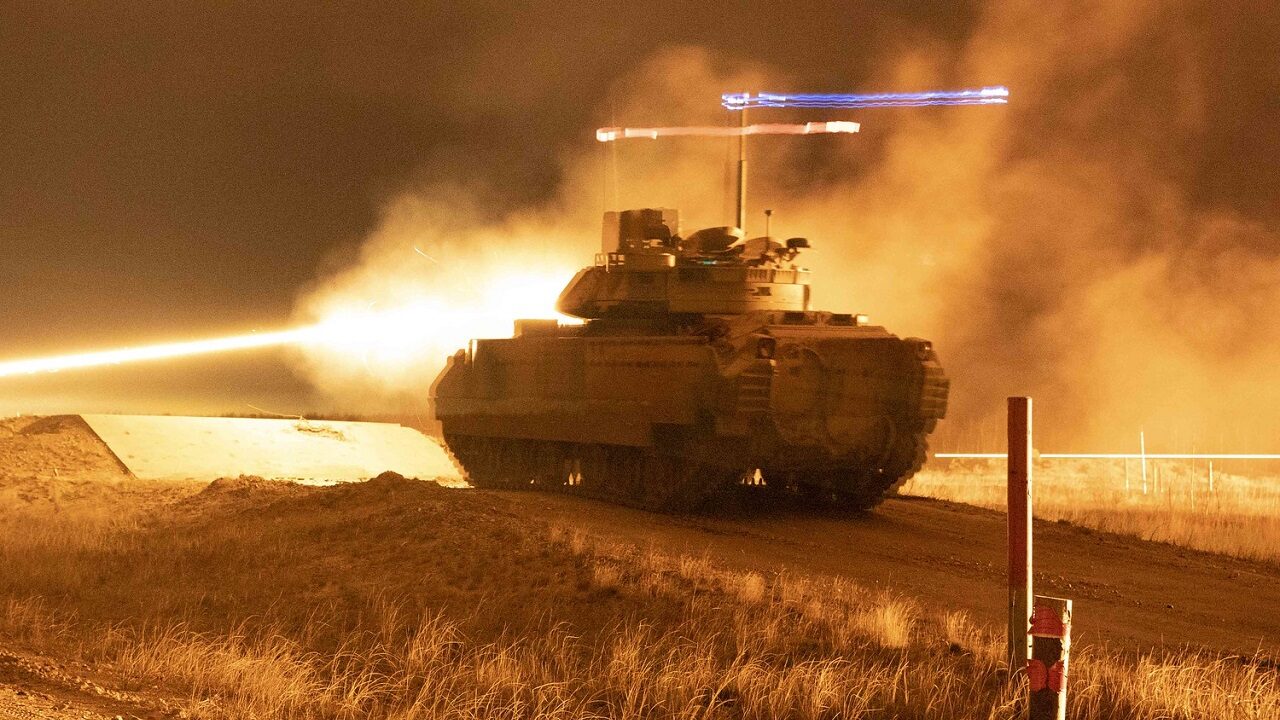On Thursday, Bloomberg reported the Biden administration was considering sending Bradley Infantry Fighting Vehicles to Ukraine. If he decides to go through with the transfer, this would mark the most heavily armed and armored Western-designed fighting vehicle given to Ukraine to date.
(Subscribe to Our YouTube Channel Here.)
Operated by a crew of three, each Bradley weighs between 27 and 33 tons and can carry a squad of 6 or 7 soldiers, depending on model. They can maul infantry and light armored vehicles using rapid-firing 25-millimeter cannons and a machinegun, and can snipe at distant tanks using a two-shot TOW anti-tank missile launcher. The Bradley, named after World War II general Omar Bradley, entered U.S. services in the 1980s in two basic but highly similar variants, the M2 used by infantry units and the M3 by cavalry-scout formations.
Let’s consider a few key factors that will weigh in Washington’s ultimate decision.
The U.S. and NATO are nervous about giving Ukraine tanks. The Bradley is the next best thing.
Washington and its NATO allies have, rightly or wrongly, feared that certain weapons are too provocative to give Ukraine and risk inciting dangerous escalation by Putin. Those particularly pertain to jet fighters and Western-built main battle tanks. An oddity of this policy is that NATO has given plenty of advanced artillery systems to Ukraine that are likely to cause more Russian losses than tanks; and air defense systems that are far more expensive and advanced.
Nonetheless, Ukraine wants to continue launching offensives to liberate territory—and offensives require lots of well-protected fighting vehicles.
The Bradley is an infantry fighting vehicle (IFV)— designed to transport troops into combat and provide anti-personnel and anti-vehicle fire support while doing so. So it has a much more aggressive combat role than the hundreds of lightly-armed armored personnel carriers like the M113 and VAB that NATO has donated to Ukraine.
Still, a Bradly isn’t a main battle tank—it lacks a large cannon and it’s armor isn’t meant to withstand hits from tank guns or powerful anti-tank missiles. But it’s more or less the next best thing. And Ukraine and Russia both already use lots of infantry fighting vehicles—mostly Soviet-era BMP tracked IFVs.
The Pentagon has thousands of them to spare.
Bradleys aren’t cheap, priced at roughly $3.2 million per vehicle by 2000. But the U.S. has already paid for roughly 6,500 Bradleys, over a third of which are no longer in use with Army and National Guard units (see table below).

An M2 Bradley Fighting Vehicle is on display during a training exercise at the National Training Center in Fort Irwin, Calif., Feb. 18, 2013. The live, virtual and constructive training environment of the National Training Center is designed to produce adaptive leaders and agile forces for the current fight, which are responsive to the unforeseen contingencies of the 21st century. (U.S. Army photo by Sgt. Eric M. Garland II/Released)
|
Bradley in Operational Units and Storage* |
||
|
|
Estimated number in operational units |
Estimated number in storage |
|
M2 Infantry Fighting Vehicle |
2,500 |
2,000 |
|
M3 Cavalry Fighting Vehicle |
1,200 |
800 |
|
M73A3 Fire Support Vehicle (for artillery spotting) |
334 |
|
|
Figures from IISS’s The Military Balance 2021 |
||
The Army therefore can afford to give away hundreds of Bradleys without stripping capability from operational units, which in 2022 just began to receive new M2A4 vehicles with uprated power trains and suspensions, as well as survivability improvements and digitized systems. Long term it plans to replace them with an optionally-manned successor.
Of course, any earlier M2A1 and M2A2 in storage lack key survivability upgrades, and so it’s possible the Pentagon would spend some money upgrading them before donating them.
It’s a lot tougher (and heavier) than Ukraine and Russia’s BMP fighting vehicles.
The BMP-2 fighting vehicles used widely by Ukraine and Russia weigh 15.8 tons—while a Bradley weighs twice as much at 33 tons in later models! A lot of that difference is due to more robust armor. For example, side and rear armor on BMPS can be penetrated by heavy machine gun rounds at close range, while a Bradley is protected from all angles against such weapons.
Furthermore, the Bradley’s smaller 25-millimeter cannon can easily blast through a BMP’s frontal armor, while the BMP’s 30-millimeter gun struggle against the Bradley’s front plate. That said, Russia’s later BMP-3 model does outgun the Bradley as it pack an additional 100-millimeter gun.
Bradleys are also one of the few U.S. armored vehicles designed to bolt-on bricks of explosive reactive armor, which can help defeat common light anti-tank weapons like rocket propelled grenades that would ordinarily penetrate.
It also comes with superior sensors, particularly including night-fighting capable passive thermal sights, which all but small numbers of modernized BMPs lack.
It has long-range tank-busting missiles.
Like BMPs, Bradleys carry long-distance missiles to defend against tanks—specifically the BGM-71 TOW, which has a range exceeding 2 miles and is also useful for precise strikes on fortified positions, heavy weapons team and supply trucks. Newer TOW missiles feature wireless command links and top-attack munitions that may have better odds of overcoming reactive armor and active protection systems on Russian tanks. Ukraine has already received at least 1,500 infantry TOW missiles from the U.S., a few of which have been recorded used in combat.
Bradleys have their downsides.
The Bradley’s belly armor wasn’t designed for mine-resistance, so it remains relatively vulnerable to mines and improvised explosive devices despite its heavy armor. And in common with BMPs, Bradleys can only carry small squads of six or seven dismounted soldiers.
Though Bradleys have increased several tons in weight over the years, most continue to use the same 500-horsepower diesel engine. That means up-armored Bradleys are underpowered and stress their power train and suspensions—except for brand-new M2A4s.
The logistical burden would be considerable.
Because Bradleys are so much heavier than Ukraine’s BMPs, they would impose a greater logistical burden and will require more intensive support structures to keep fueled, maintained and repaired in the field than are currently organic to Ukrainian mechanized units.
And unlike for old Soviet armored vehicles donated by NATO to Kyiv, Ukraine’s military has no prior experience operating Bradleys, and would have to set up completely new maintenance, supply and training pipelines to support the new type. That would take months, though Ukraine’s military has so far managed to rush complex new capabilities like HIMARS into the field surprisingly fast.
The Bradley’s development was so controversial somebody made a comedy movie about it.
Built to satisfy diverging requirements from the U.S. Army’s mechanized infantry and cavalry reconnaissance units, the Bradley took many years and billions of dollars to develop, leading that process to be satirized in the film The Pentagon Wars. However these cinematic hijinks shouldn’t be over-interpreted; Bradley have performed well in combat since the 1991 Gulf War, and their basic design is hardly unusual.
How practical are Bradleys for Ukraine?
The U.S. has literally thousands of spare Bradleys it’s not using that it can sign off to Ukraine at little cost. But the logistical and training measures needed to integrate Bradleys into Ukraine’s military and support them in the field, would remain significant. For that reason, a U.S. transfer of these would need to be of sufficient scale, and effectively sustained over enough time to ensure a worthwhile return on the effort invested.
If fielded, Ukrainian mechanized brigades with Bradleys more likely to survive enemy fire, fight more flexibly thanks to superior night vision sensors, and more likely to detect and destroy enemy vehicles with their own weapons first. Its logistical footprint, however, would be quite literally heavier.
Bradleys wouldn’t be ‘game changers’—but, if delivered in adequate quantity, could still enhance and expand Ukraine’s ground maneuver forces, which need such protected mobility vehicles to recapture Ukrainian territory. So they could eventually contribute to Kyiv’s endgame of driving Russian forces out of Ukraine through a combination of attrition and maneuver.
More: Can a Coup Takedown Putin for Good?
More: Is Donald Trump Going Crazy?
More: Could Mike Pence Beat Donald Trump in 2024?
More: NATO vs. Russia – What World War III Would Look Like
Sébastien Roblin writes on the technical, historical and political aspects of international security and conflict for publications including The National Interest, NBC News, Forbes.com, War is Boring and 19FortyFive, where he is Defense-in-Depth editor. He holds a Master’s degree from Georgetown University and served with the Peace Corps in China. You can follow his articles on Twitter.

